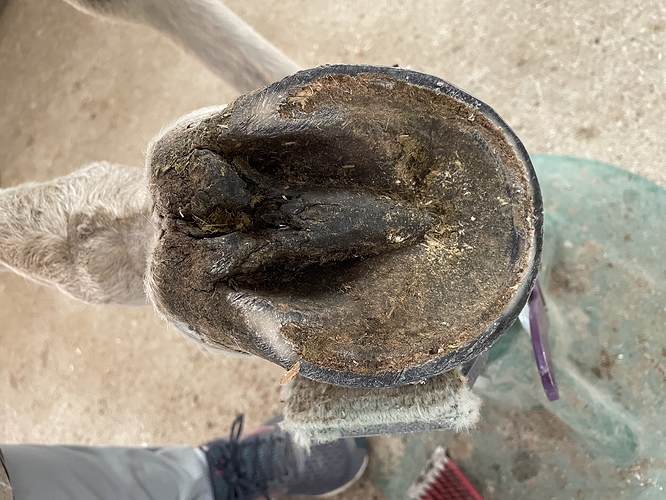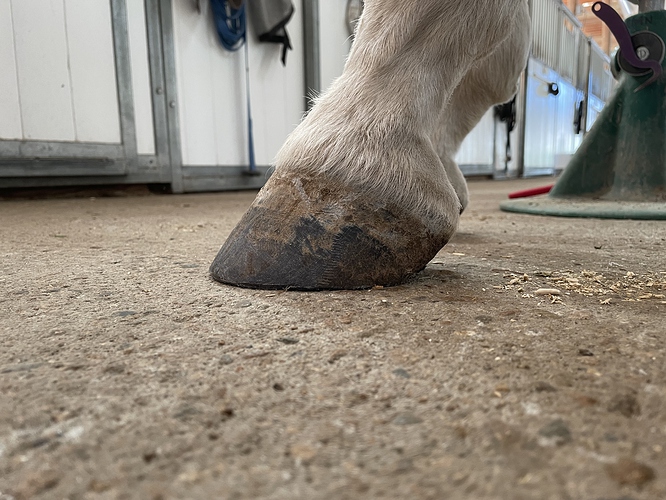Could y’all explain just what this is and what it looks like on the bottom of the hoof? Does shoeing affect it?
Thanks. Body worker suggested my guys heels are a bit contracted and before I mention it to farrier I need some education!
The butt crack heel is usually a pretty good give away.
Like, ummmmmm, let’s find a pic. Great and extreme example here.
You have Iberians, right?
If so, they’re rather prone to contracted heels in my experience. Especially if they were imported from Spain. IME, they’ll almost always be a bit more contracted and upright than most other horses. Which is ok, to some extent. Their hooves are built like that for a reason (mainly hard terrain like what you might find in Spain).
That being said, they can be too contracted/you don’t necessarily want contracted heels. Poor shoeing will effect it, and the best cure that I’ve found for contracted heels is going unshod with a good trimmer/farrier, but I understand that might not work for everyone.
You’ll notice a more oval vs round hoof shape, generally. And a deeper sulcus.
These are random images from Google that illustrate contracted heels:
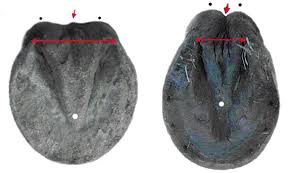
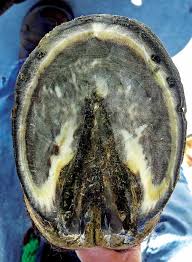
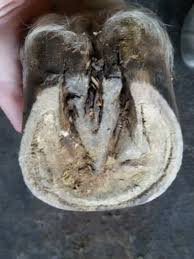
Shoeing can be an issue, but it isn’t always the issue. But contracted heels can point to sore heels (horse not willing to weight it) which will lead to soreness elsewhere, so it’s usually a good idea to get to the bottom of it.
It can also be a chicken and egg thing, with the sore body causing contracted heels (if it affects the horses movement to a great degree).
Shoes themselves don’t cause contraction. The trim is nearly always the underlying factor, and then shoes exacerbate trimming issues
But body movement issues can cause contracture as well. Stalled horses are more likely to have contracted heels than horses out full time on lots of pasture. Body issues that don’t allow for a good long stride and a heel first, or at least flat landing, can end up allowing heels to contract.
The center of the back of the frog should look like clay that someone pressed their thumb into. Not all contracted heels have a crack, yet, but I’ve never seen a crack in a wide healthy frog, at least not one caused by something external.
If you draw a line from the seat of corn, where wall turns into bar, that sharp angle, forward towards the toe, there should be very little hoof wall outside of that. Look at CanteringCarrot’s left-most picture, and draw lines straight down from each red dot… Then look at that next picture - if you draw that same line, there’s quite a lot of hoof outside of it
Thanks everyone. Ive had a new farrier for a few months (after 6 months or so of a not-so-great farrier, who let his heels slide under despite me mentioning it every time… )
We have been working to get the heels out form under so much, the toe shorter, and the foot more upright…
We are almost there.
Thanks everyone.
and @CanteringCarrot, yes, PRE. He came to me with crappy feet, and various farrier issues prevented resolution until now. You would think an area like this would have a surplus of good farriers, but it doesnt… now I have one.
Take regular solar and lateral views of each foot, at as close to the same time after each trim as you can. Day of is best, but within a week is good enough. That’ll let you objectively track progress, as it’s hard to remember what 4-6 weeks ago looked like, and sometimes progress is slow.
It’s amazing how high equine population areas are still a farrier desert 
I agree Cantering Carrot…at least for my mare. She is 1/2 Andalusian. I have always said she has ‘muley’ feet. She has been BF for all but about 6 months at 4, 5, and 6 yrs old. I was able to get some widening of her heels with using Sure Foot pads. We are also in the desert. Usually from May to November it is very dry with hot summers.
Here is a pic of her left front last September…she is now 22. Pardon all the rasp marks  . This was my first attempt at a full trim. I have gotten better. I was doing pretty good to get this much done as it was September…they are like rocks. I was not able to do much on her frog or bars.
. This was my first attempt at a full trim. I have gotten better. I was doing pretty good to get this much done as it was September…they are like rocks. I was not able to do much on her frog or bars.
How much does hoof conformation play into this? I had a QH where I tried her barefoot, I tried duplos, she was mostly in conventional steel shoes, I’d seen her under four different farriers, I tried artimud and tomorrow… nothing made a huge dent in the overall shape of her hoof and she always had some level of central sulcus crack. My latest farrier was convinced it was how her hoof wanted to grow.
the more upright a foot is, and especially the greater the degree of club foot, the more contracted heels will be, relative to ideal. But while normal for, say, a grade 2 club is more contracted than a non-club, very textbook foot, it’s normal for that foot, and you have to gauge inappropriate contraction from there
Such a Haaaard problem to fix. You basically need your farrier on retainer and on call. I feel that pain.

